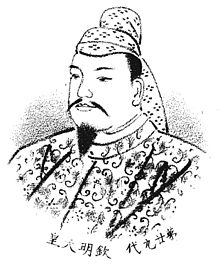| Kinmei 欽明天皇 | |||||
|---|---|---|---|---|---|
| Great King of Yamato | |||||
 | |||||
| Emperor of Japan | |||||
| Reign | December 5, 539 – April 15, 571[verification needed] | ||||
| Predecessor | Senka | ||||
| Successor | Bidatsu | ||||
| Born | 509 Japan | ||||
| Died | 15 April 571 (aged 62) Asuka, Yamato | ||||
| Burial | Hinokuma no saki Ai no misasagi (檜隈坂合陵) (Nara) | ||||
| Spouse | Ishi-hime | ||||
| Issue among others... | |||||
| |||||
| House | Imperial House of Japan | ||||
| Father | Emperor Keitai | ||||
| Mother | Princess Tashiraka | ||||
| Religion | Shinto | ||||
Emperor Kinmei (欽明天皇, Kinmei-tennō, 509–571) was the 29th emperor of Japan,[1] according to the traditional order of succession.[2][3] His reign is said to have spanned the years from 539 to 571. Some historians regard Kinmei as the first historically verifiable Japanese emperor.[4][3]
Kinmei's contemporary title would not have been tennō, as most historians believe this title was not introduced until the reigns of Emperor Tenmu and Empress Jitō. Rather, it was presumably Sumeramikoto or Amenoshita Shiroshimesu Ōkimi (治天下大王), meaning "the great king who rules all under heaven". Alternatively, Kinmei might have been referred to as ヤマト大王/大君 or the "Great King of Yamato".
Because of several chronological discrepancies in the account of Emperor Kinmei in the Nihon Shoki, some believe that he was actually ruling a rival court to that of Emperors Ankan and Senka. Nevertheless, according to the traditional account, it was not until the death of Emperor Kinmei's older brother Emperor Senka that he gained the throne.
According to this account, Emperor Senka died in 539 at the age of 73;[5] and succession passed to the third son of Emperor Keitai. This Imperial Prince was the next youngest brother of Emperor Senka. He would come to be known as Emperor Kinmei. He established his court at Shikishima no Kanazashi Palace (磯城嶋金刺宮) in Yamato.[6]
The Emperor's chief counselors were:
Although the imperial court was not moved to the Asuka region of Japan until 592, Emperor Kinmei's rule is considered by some to be the beginning of the Asuka period of Yamato Japan, particularly by those who associate the Asuka period primarily with the introduction of Buddhism to Japan from Baekje.
According to the Nihon Shoki, Emperor Kinmei received a bronze statue of Gautama Buddha as a gift from the king of Baekje King Song Myong (聖明王, Seimei Ō) along with a significant envoy of artisans, monks, and other artifacts in 552. (However, according to the Jōgū Shōtoku Hōō Teisetsu, Buddhism was introduced in 538.) This episode is widely regarded as the official introduction of Buddhism to the country.
With the introduction of a new religion to the court, a deep rift developed between the Mononobe clan, whose members supported the worship of Japan's traditional deities, and the Soga clan, whose members supported the adoption of Buddhism.
According to the Nihon Shoki, Emperor Kinmei ruled until his death in 571 and was buried in the Hinokuma no Sakai Burial Mound (桧隈坂合陵). An alternate stronger theory holds that he was actually buried in the Misemaruyama Tumulus (見瀬丸山古墳), located in Kashihara City (橿原市).
The Emperor is traditionally venerated at a memorial Shinto shrine (misasagi) at Nara. The Imperial Household Agency designates the Nara location as Kinmei's mausoleum.[1] It is formally named Hinokuma no saki Ai no misasagi.[7] However, the actual sites of the graves of the early Emperors are unclear, according to some historians and archaeologists.
Emperor Kinmei's father was Emperor Keitai and his mother was Emperor Ninken's daughter, Princess Tashiraka (手白香皇女, Tashiraka no himemiko).[6] In his lifetime, he was known by the name Amekuni Oshiharaki Hironiwa (天国排開広庭).
Kinmei had six Consorts and 25 Imperial children (16 sons and 9 daughters).[6] According to Nihongi, he had six wives, but the Kojiki gives only five wives; identifying the third consort to be the same as the sixth one. The first three were his nieces, daughters of his half-brother Emperor Senka; two others were sisters, daughters of the Omi Soga no Iname.